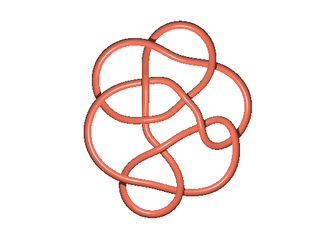 W
WIn mathematical knot theory, a link is a collection of knots which do not intersect, but which may be linked together. A knot can be described as a link with one component. Links and knots are studied in a branch of mathematics called knot theory. Implicit in this definition is that there is a trivial reference link, usually called the unlink, but the word is also sometimes used in context where there is no notion of a trivial link.
 W
WIn knot theory, a branch of topology, a Brunnian link is a nontrivial link that becomes a set of trivial unlinked circles if any one component is removed. In other words, cutting any loop frees all the other loops.
 W
WThe carrick mat is a flat woven decorative knot which can be used as a mat or pad. Its name is based on the mat's decorative-type carrick bend with the ends connected together, forming an endless knot. A larger form, called the prolong knot, is made by expanding the basic carrick mat by extending, twisting, and overlapping its outer bights, then weaving the free ends through them. This process may be repeated to produce an arbitrarily long mat.
 W
WIn mathematics, in particular in knot theory, the Conway knot is a particular knot with 11 crossings, named after John Horton Conway.
 W
WIn the mathematical theory of knots, L10a140 is the name in the Thistlethwaite link table of a link of three loops, which has ten crossings between the loops when presented in its simplest visual form. It is of interest because it is presumably the simplest link which possesses the Brunnian property — a link of connected components that, when one component is removed, becomes entirely unconnected — other than the six-crossing Borromean rings.
 W
WSolomon's knot is a traditional decorative motif used since ancient times, and found in many cultures. Despite the name, it is classified as a link, and is not a true knot according to the definitions of mathematical knot theory.
 W
WIn the mathematical field of knot theory, an unlink is a link that is equivalent to finitely many disjoint circles in the plane.
 W
WIn knot theory, the Whitehead link, named for J. H. C. Whitehead, is one of the most basic links.